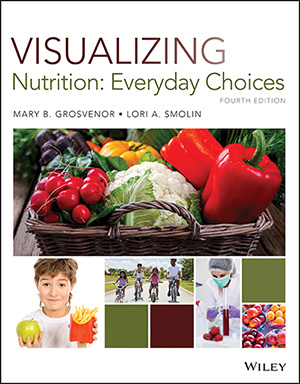
Visualizing Nutrition: Everyday Choices, 4th Edition
By Mary Grosvenor and Lori Smolin
Visualizing Nutrition: Everyday Choices offers students a valuable opportunity to identify and connect the central issues of nutritional science in a visual approach. Developed for a one-semester introductory nutrition course, this title fits well at both two- and four-year schools. As students explore important nutrition topics, they are immersed in content that not only provides valuable scientific understanding, but also demonstrates relevance to their personal lives.
The next generation of WileyPLUS for Visualizing Nutrition gives instructors the freedom and flexibility to tailor content and easily manage their course to keep students engaged and on track.
Schedule a Demo Request Instructor AccountWant to learn more about WileyPLUS? Click Here
Videos underscore the importance of nutritional choices on health.
Food for Thought is an extensive video suite available through the next generation of WileyPLUS. These videos introduce upcoming course section concepts, illuminate difficult scientific concepts, and point out helpful practice opportunities and resources in WileyPLUS. Assignable question sets are available for all videos. Instructor tips videos and an Instructor’s Manual are also provided, which demonstrate section-specific teaching tips and strategies suitable for all different types of classroom environments, including online and flipped classrooms.

Adaptive practice helps students prepare for class or quizzes and exams.
Active retrieval of information with practice questions is proven to improve retention of information better than re-reading or reviewing the material, and students who use adaptive practice to prepare for exams do significantly better than those who do not. Students begin with a quick, section-level diagnostic to determine their initial level of understanding, and they can use the dashboard and quick reports to see what topics they know and don’t know.

Students can track food intake, add foods, and calculate the impact of physical activity.
The iProfile Dietary Analysis software includes information on over 50,000 foods, including ethnic, cultural, and popular brand-name choices. Serving size animations, a self-discovery survey, single-nutrient reports, menu planning and more make this a valuable tool.
What’s New
- Food for Thought Video Library: This library includes associated assessments and an Instructor’s Guide to accompany the videos.
- Updated iProfile Database
- Calculating Activities: These unique resources let students create a meal and calculate the calories and percent of calories from each of the macronutrients. There is no limit to variations of portions used in the meal. Users can practice calculating calories and percent of calories multiple times.
- Updated Video Resources: New videos focus on the most current, relevant topics in nutrition such as the new food label regulations, meeting protein needs with vegan diets, herbal supplements, and biotechnology. All videos have accompanying assessments.
- Focus on Metabolism: A fully illustrated online appendix within WileyPLUS serves as a summary of the metabolism information that students learn in this course.
- New and Updated Discussion Questions: These questions help build a student’s critical thinking skills and provide a useful resource for in-class discussions.
- Mobile Media Assets: Now accessible on tablets, these assets include How It Works Animations (with closed captioning for ADA compliance).
Mary B. Grosvenor holds a bachelor of arts in English from Georgetown University and a master of science in nutrition science from the University of California at Davis. This combination provides her an ideal background for nutrition writing. She is a registered dietitian and has worked in clinical as well as research nutrition and in hospitals and communities, large and small, in the western United States. She teaches at the community college level and has published articles in peer-reviewed journals in nutritional assessment and nutrition and cancer. Her training and experience provide practical insights into the application and presentation of the science in this text.
Lori A. Smolin received a bachelor of science degree from Cornell University, where she studied human nutrition and food science. She received a doctorate from the University of Wisconsin at Madison, where her doctoral research focused on B vitamins, homocysteine accumulation, and genetic defects in homocysteine metabolism. She completed postdoctoral training both at the Harbor–UCLA Medical Center, where she studied human obesity, and at the University of California–San Diego, where she studied genetic defects in amino acid metabolism. She has published articles in these areas in peer-reviewed journals. Smolin is currently at the University of Connecticut, where she has taught both in the Department of Nutritional Science and in the Department of Molecular and Cell Biology. Courses she has taught include introductory nutrition, life cycle nutrition, food preparation, nutritional biochemistry, general biochemistry, and introductory biology.
- Nutrition: Everyday Choices
- Guidelines for a Healthy Diet
- Digestion: From Meals to Molecules
- Carbohydrates: Sugars, Starches, and Fibers
- Lipids: Fats, Phospholipids, and Sterols
- Proteins and Amino Acids
- Vitamins
- Water and Minerals
- Energy Balance and Weight Management
- Nutrition, Fitness, and Physical Activity
- Nutrition During Pregnancy and Infancy
- Nutrition from 1 to 100
- How Safe Is Our Food Supply?
- Feeding the World
Online Only Section: Metabolism

